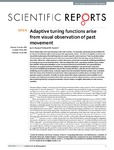Adaptive tuning functions arise from visual observation of past movement
| dc.contributor.author | Howard, Ian | |
| dc.contributor.author | Franklin, DW | |
| dc.date.accessioned | 2016-06-26T08:53:12Z | |
| dc.date.available | 2016-06-26T08:53:12Z | |
| dc.date.issued | 2016-06-24 | |
| dc.identifier.issn | 2045-2322 | |
| dc.identifier.issn | 2045-2322 | |
| dc.identifier.other | 28416 | |
| dc.identifier.uri | http://hdl.handle.net/10026.1/4960 | |
| dc.description.abstract |
Visual observation of movement plays a key role in action. For example, tennis players have little time to react to the ball, but still need to prepare the appropriate stroke. Therefore, it might be useful to use visual information about the ball trajectory to recall a specific motor memory. Past visual observation of movement (as well as passive and active arm movement) affects the learning and recall of motor memories. Moreover, when passive or active, these past contextual movements exhibit generalization (or tuning) across movement directions. Here we extend this work, examining whether visual motion also exhibits similar generalization across movement directions and whether such generalization functions can explain patterns of interference. Both the adaptation movement and contextual movement exhibited generalization beyond the training direction, with the visual contextual motion exhibiting much broader tuning. A second experiment demonstrated that this pattern was consistent with the results of an interference experiment where opposing force fields were associated with two separate visual movements. Overall, our study shows that visual contextual motion exhibits much broader (and shallower) tuning functions than previously seen for either passive or active movements, demonstrating that the tuning characteristics of past motion are highly dependent on their sensory modality. | |
| dc.format.extent | 28416- | |
| dc.format.medium | Electronic | |
| dc.language | en | |
| dc.language.iso | en | |
| dc.publisher | Nature Scientific Reports | |
| dc.subject | Adaptation, Psychological | |
| dc.subject | Female | |
| dc.subject | Humans | |
| dc.subject | Male | |
| dc.subject | Models, Psychological | |
| dc.subject | Motor Activity | |
| dc.subject | Photic Stimulation | |
| dc.subject | Psychomotor Performance | |
| dc.subject | Spatial Memory | |
| dc.subject | Statistics, Nonparametric | |
| dc.subject | Young Adult | |
| dc.title | Adaptive tuning functions arise from visual observation of past movement | |
| dc.type | journal-article | |
| dc.type | Journal Article | |
| plymouth.author-url | https://www.webofscience.com/api/gateway?GWVersion=2&SrcApp=PARTNER_APP&SrcAuth=LinksAMR&KeyUT=WOS:000378596900001&DestLinkType=FullRecord&DestApp=ALL_WOS&UsrCustomerID=11bb513d99f797142bcfeffcc58ea008 | |
| plymouth.issue | 1 | |
| plymouth.volume | 6 | |
| plymouth.publisher-url | http://www.nature.com/srep/ | |
| plymouth.publication-status | Published online | |
| plymouth.journal | Scientific reports | |
| dc.identifier.doi | 10.1038/srep28416 | |
| plymouth.organisational-group | /Plymouth | |
| plymouth.organisational-group | /Plymouth/Faculty of Science and Engineering | |
| plymouth.organisational-group | /Plymouth/Faculty of Science and Engineering/School of Engineering, Computing and Mathematics | |
| plymouth.organisational-group | /Plymouth/REF 2021 Researchers by UoA | |
| plymouth.organisational-group | /Plymouth/REF 2021 Researchers by UoA/UoA11 Computer Science and Informatics | |
| plymouth.organisational-group | /Plymouth/Users by role | |
| plymouth.organisational-group | /Plymouth/Users by role/Academics | |
| dc.publisher.place | England | |
| dcterms.dateAccepted | 2016-05-31 | |
| dc.identifier.eissn | 2045-2322 | |
| dc.rights.embargoperiod | No embargo | |
| rioxxterms.versionofrecord | 10.1038/srep28416 | |
| rioxxterms.licenseref.uri | http://www.rioxx.net/licenses/all-rights-reserved | |
| rioxxterms.licenseref.startdate | 2016-06-24 | |
| rioxxterms.type | Journal Article/Review | |
| plymouth.oa-location | https://www.nature.com/articles/srep28416 |


